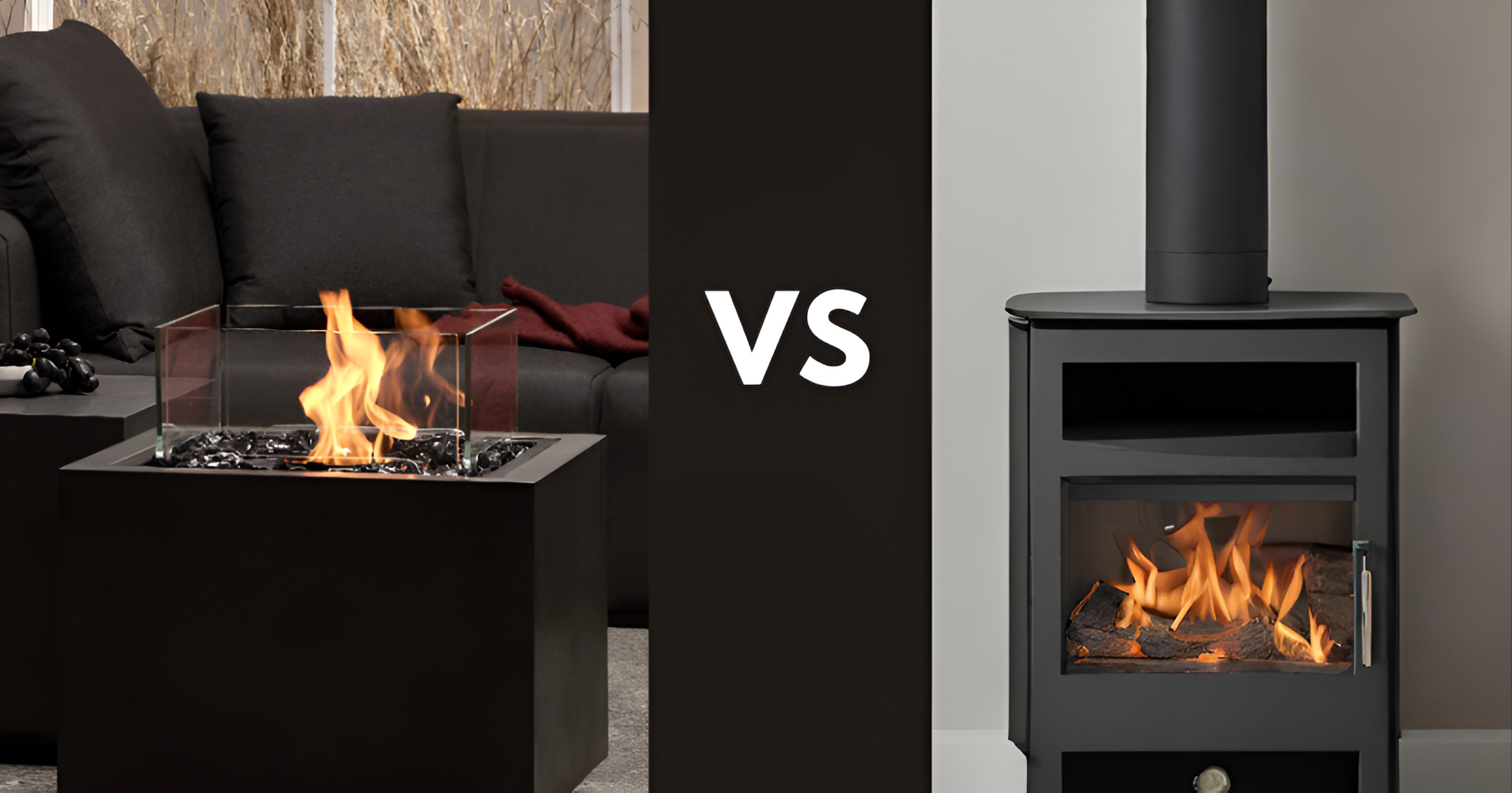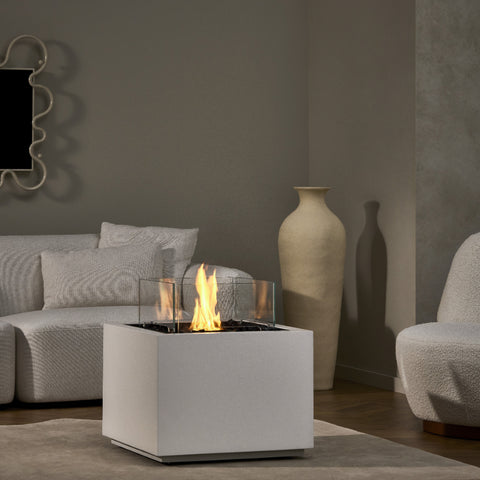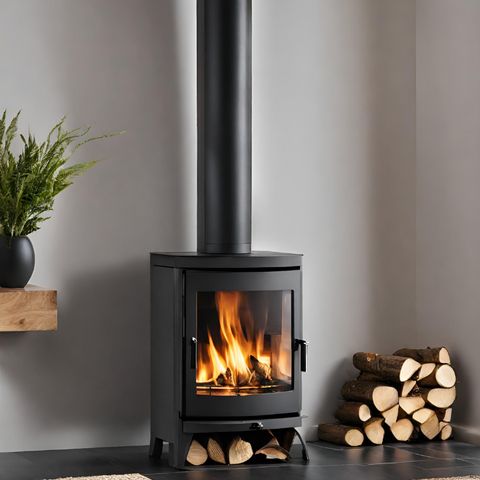
Bioethanol Fire vs Log Burner: Best Choice for You
When it comes to eco-friendly heating options, bioethanol fires and log burners are two popular choices for sustainable home heating. If you're in the market for an energy-efficient fireplace, it's important to understand the differences between these two options and determine which one is best suited to your needs.
Bioethanol fires, also known as biofireplaces, are fueled by bioethanol, a renewable and clean-burning fuel derived from plants such as sugarcane and corn. These fires offer a convenient and smoke-free heating solution, as they require no chimney or flue. On the other hand, log burners use wood as their fuel source, providing a traditional and cosy ambiance.
When considering the environmental impact, bioethanol fires are considered to be more eco-friendly. They produce lower levels of carbon dioxide (CO2) emissions compared to log burners, making them a greener choice. Additionally, bioethanol is sourced from renewable materials, contributing to sustainable home heating.
In terms of energy efficiency, bioethanol fires have an edge over log burners. They produce a higher amount of heat per unit of fuel consumed, resulting in better thermal efficiency. This not only keeps your home warm and comfortable but also helps reduce energy costs in the long run.
While bioethanol fires offer advantages in terms of convenience, sustainability, and energy efficiency, it's important to consider some drawbacks as well. Bioethanol can be more expensive than wood, and ongoing fuel costs should be factored into your decision. Additionally, bioethanol fires may require more frequent refilling compared to log burners that can burn wood for a longer period.
When it comes to installation, both options have their requirements. Bioethanol fires are relatively easy to install, as they do not require any chimney or ventilation system. On the other hand, log burners need a chimney or flue for the release of smoke and gases.
Safety is a significant aspect to consider when choosing between a bioethanol fire and a log burner. While both options have safety measures in place, it's important to follow the manufacturer's guidelines and take precautions to ensure safe usage.

Key Takeaways:
- Bioethanol fires and log burners are both eco-friendly heating options for sustainable home heating.
- Bioethanol fires use bioethanol as a clean-burning and renewable fuel source, while log burners use wood.
- Bioethanol fires are more environmentally friendly, producing lower CO2 emissions and using renewable materials.
- Bioethanol fires are more energy-efficient, providing better thermal efficiency and potentially reducing energy costs.
- Consider the cost of bioethanol fuel and the convenience of refilling compared to the longer burning time of wood in log burners.
- Installation requirements differ for bioethanol fires (no chimney required) and log burners (chimney or flue necessary).
- Follow safety guidelines and precautions for both bioethanol fires and log burners to ensure safe usage.
Understanding Bioethanol Fires and Log Burners
When it comes to environmentally friendly heating solutions, bioethanol fires and log burners are two popular options to consider. Both offer an alternative to traditional fossil fuel-based heating systems, but they differ in terms of fuel sources, energy efficiency, and overall user experience.

Fuel Sources
Bioethanol fires, also known as biofireplaces or ethanol fireplaces, use a renewable and sustainable fuel called bioethanol. Bioethanol is produced from agricultural by-products such as corn, sugarcane, or wheat, making it a greener and more environmentally friendly choice compared to fossil fuels.
On the other hand, log burners rely on burning wood logs as their primary fuel source. While wood is a renewable resource, it is important to ensure that the logs used are sustainably sourced to minimise environmental impact.
Energy Efficiency
When it comes to energy efficiency, bioethanol fires have the advantage. They convert almost 100% of the fuel's energy into heat, maximising efficiency and reducing waste. In contrast, log burners are typically less efficient, with some heat lost through the chimney or stovepipe during the burning process.
Environmental Impact
Both bioethanol fires and log burners have a lower carbon footprint compared to traditional fossil fuel-based heating systems. Bioethanol fires produce minimal emissions when burning and do not release harmful pollutants or particulate matter into the air. Log burners, while generally cleaner than open fires, still emit smoke and particulate matter, which can contribute to air pollution.
Heating Process and User Experience
One of the key differences between bioethanol fires and log burners is the heating process. Bioethanol fires provide instant heat and are quick to warm up a room. They are also easy to control, allowing users to adjust the flame intensity and heat output according to their preferences.
Log burners, on the other hand, require more time to generate heat as the logs burn, and the heat output is typically higher compared to bioethanol fires. However, users need to manage the fire, adding logs and adjusting the airflow to maintain the desired heat level.
Benefits and Drawbacks of Bioethanol Fires and Log Burners
When considering the best heating option for your home, it's essential to weigh the benefits and drawbacks of bioethanol fires and log burners. Each option has unique advantages and considerations that can impact your decision. Let's explore the characteristics of both bioethanol fires and log burners.
Bioethanol Fires
Benefits:
- Environmentally Friendly: Bioethanol fires burn clean and produce minimal emissions, making them an eco-friendly choice for sustainable home heating.
- Energy Efficiency: These fireplaces provide efficient heat, ensuring that you stay warm while minimising energy wastage.
- Flexibility: Bioethanol fires are portable and do not require a chimney or flue, allowing you to place them in various locations within your home.
- Easy Installation: With no need for complicated installation or venting systems, bioethanol fires are simple to set up and use.
- Aesthetic Appeal: These fires offer sleek and modern designs, adding a stylish touch to any home decor.
Drawbacks:
- Cost of Fuel: Bioethanol fuel can be more expensive than traditional wood or other fuel sources, resulting in higher ongoing costs.
- Heat Output: While bioethanol fires provide adequate heat for most spaces, they may not be as effective for heating larger areas.
- Flame Control: Some bioethanol fireplaces may have limited flame control options, which may affect the ambiance and heat settings.

Log Burners
Benefits:
- Natural and Traditional: Log burners use wood as fuel, embracing a traditional heating method that many find appealing.
- Cost-Effective: Depending on your location and access to wood, log burners can be a cost-effective heating option, especially if you have a sustainable source of wood.
- Heat Output: Log burners can generate significant heat, making them suitable for large spaces and open-plan areas.
- Atmosphere: The crackling sound and authentic aroma of burning wood create a cosy and inviting ambiance.
Drawbacks:
- Environmental Impact: Wood-burning releases particulate matter and pollutants into the air, contributing to air pollution and potential health risks.
- Installation Requirements: Log burners typically require professional installation, including a flue or chimney, which adds to the upfront costs.
- Maintenance: Regular cleaning and maintenance are necessary for log burners to ensure efficient and safe operation.
- Safety Considerations: Safety precautions, such as storing and handling wood and managing fire risks, should be taken when using a log burner.

By considering the benefits and drawbacks of bioethanol fires and log burners, you can make an informed decision based on your specific needs, budget, and priorities. Whether you prioritise environmental sustainability, energy efficiency, or the traditional charm of a log burner, understanding the pros and cons will guide you towards the ideal heating solution for your home.
Conclusion
After carefully considering the benefits and drawbacks of bioethanol fires and log burners, it is clear that both options offer unique advantages for home heating. When choosing between a bioethanol fire and a log burner, several factors should be taken into account.
If energy efficiency and environmental impact are your top priorities, a bioethanol fire may be the ideal choice for you. Bioethanol fires are known for their clean burn, producing no smoke, soot, or harmful emissions. They are also highly efficient, providing instant heat without the need for a chimney or flue.
On the other hand, if you value the traditional ambiance and aroma of a real wood-burning fireplace, a log burner would be the recommended option. Log burners offer a tactile and visually appealing experience, creating a warm and inviting atmosphere in your home. However, it's important to consider the maintenance and safety requirements that come with using a log burner.
In conclusion, the choice between a bioethanol fire and a log burner ultimately depends on your specific needs, preferences, and the overall aesthetics you desire for your home. Take into account factors such as energy efficiency, environmental impact, ease of maintenance, and personal taste to make an informed decision that will enhance the comfort and sustainability of your living space.
Other content you'll love:
Understanding Bioethanol Fireplaces Functionality
Safety of Indoor Bioethanol Fires Explained
Is a Flue Necessary for Bioethanol Fires?
Do Bioethanol Fires Produce CO2? Get Facts Here
Bioethanol Safety Guide: Is Bioethanol Flammable?
Bioethanol Fires Warmth – Get Cosy & Efficient Heat
Bioethanol Fires Safety Guide: Are They Dangerous?
Bioethanol Fires Running Costs Explained
Bioethanol Fires: Is Ventilation Required?
Bioethanol Fires: Do They Produce Heat?
Bioethanol Fires & Carbon Monoxide Risks Explained
Bioethanol Fires: Are They Electricity-Free?
Bioethanol Fireplace vs Gas: Eco-Friendly Choice?
Bioethanol Fireplace Explained: Eco-Friendly Warmth


